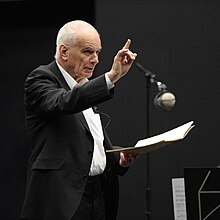| Symphony No. 6 | |
|---|---|
| by Peter Maxwell Davies | |
 The composer in 2012 The composer in 2012 | |
| Dedication | George Mackay Brown |
| Movements | 3 |
| Premiere | |
| Date | 22 June 1996 (1996-06-22) |
| Location | St Magnus Festival, Kirkwall |
| Conductor | Peter Maxwell Davies |
| Performers | Royal Philharmonic Orchestra |
The Symphony No. 6 by Peter Maxwell Davies was composed in Hoy during the first half of 1996, and was premiered on 22 June of the same year in the Phoenix Cinema, Kirkwall, as part of the twentieth St Magnus Festival, Orkney, by the Royal Philharmonic Orchestra conducted by the composer. The work was written with specific members of the RPO in mind, and is dedicated to the memory of the poet George Mackay Brown, who died on the day the symphony was completed.
Character and materials
The symphony sets out at the beginning from a slow Australian aboriginal tune, as reworked in Davies's Time and the Raven, composed the previous year, and returns to it at the end. Over the course of the symphony this theme is subjected to continual transformations. As with many of Davies's works from the time of the First Symphony onward, the Sixth Symphony establishes its own set of harmonic rules, with its own "tonics" and "dominants".
Instrumentation
The symphony is scored for piccolo, two flutes (2nd doubling alto flute), two oboes, cor anglais, two clarinets, bass clarinet, two bassoons, double bassoon, four horns, three trumpets, three trombones, tuba, timpani, five percussionists (playing glockenspiel, crotales, marimba, two wood blocks, tambourine, side drum, two bass drums, two suspended cymbals, crash cymbals, rain sticks), harp, celesta, and strings.
Analysis
The symphony is in three movements:
- Adagio – Allegro
- Adagio non troppo – Allegro
- Adagio – più animato
After the presentation of the slow theme as an introduction, the first movement becomes a "scherzo masquerading as a sonata-allegro". The opening Aboriginal-derived theme is clearly centred on E, and after wandering into other areas, the movement settles back onto E at the end, with one of the secondary pitches, B, above it.
The second movement reproduces the pattern of the first in many respects: a slow introduction, followed by faster music over a slower-moving background, as a sonata-allegro masquerading as a scherzo—the reverse of the first movement's disguise. The initial tonality once again focusses on E, but soon gives way to B and a collection of minor-third related centres: D, F and G♯. Later, the tonality shifts to B, D, and F and the movement closes with a violent passage successively centred on B, F, and finally D.
After two fast movements the finale is essentially a slow one. Like the other two, it begins with an introduction, only briefer this time, followed by transformations now attempting to reconcile everything from the diverse elements of the first and second movements. This synthesis is reflected in the tonalities. When the Aboriginal theme returns at letter U, it is supported by a timpani tattoo, first on B, then on F, then alternating D, B, and F, finally settling quietly onto a low D. This leaves the ambiguous feeling that the tonic may be E and the dominant B, or the tonic may be B with dominants D, F, and G♯.
References
- Davies 1996.
- ^ Jones 2002, p. 37.
- ^ Davies 1996, p. 4.
- Davies 1996, p. 5.
Sources
- Davies, Peter Maxwell. 1996. "Symphony No. 6". Booklet accompanying Peter Maxwell Davies: Symphony No. 6; Time and the Raven, 4–5. Royal Philharmonic Orchestra, Sir Peter Maxwell Davies (cond.). CD recording. Collins Classics 14822. : Lambourne Productions.
- Jones, Nicholas (Spring 2002). "Peter Maxwell Davies's Basic Unifying Hypothesis: Dominant Logic". The Musical Times. 143 (1878): 37–45. doi:10.2307/1004421. JSTOR 1004421.
Further reading
- McGregor, Richard (2000a). "Max the Symphonist". In Richard McGregor (ed.). Perspectives on Peter Maxwell Davies. Aldershot, Hampshire; Burlington, Vermont; Singapore; Sydney: Ashgate Publishing. pp. 115–137. ISBN 1-84014-298-7.
- McGregor, Richard. 2000b. "Reading the Runes". Perspectives of New Music 38, no. 2 (Summer): 5–29.
- Meph, Johannes. 1996. "Past or Future? Symphony No. 6 by Peter Maxwell Davies; Royal Philharmonic Orchestra". The Musical Times 137, no. 1842 (August): 33.
- Owens, Peter. 1994. "Revelation and Fallacy: Observations on Compositional Technique in the Music of Peter Maxwell Davies". Music Analysis 13, nos. 2–3 (October): 161–202.
- Warnaby, John. "Peter Maxwell Davies's Recent Music, and Its Debt to His Earlier Scores". In McGregor 2000a, pp. 75–92
| Peter Maxwell Davies | |
|---|---|
| List of compositions | |
| Opera |
|
| Ballet |
|
| Symphony |
|
| Concerto |
|
| Other works |
|
| Related | |